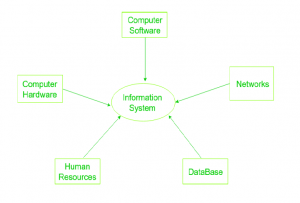COMPONENTS OF INFORMATION SYSTEMS
The main components of information systems are computer hardware and software, telecommunications, databases and data warehouses, human resources, and procedures. The hardware, software, and telecommunications constitute information technology (IT), which is now ingrained in the operations and management of organizations.
An Information system is a combination of hardware and software and telecommunication networks that people build to collect, create and distribute useful data, typically in an organizational, it defines the flow of information within the system. The objective of an information system is to provide appropriate information to the user, to gather the data, processing of the data and communicate information to the user of the system.

Components of the information system are as follows:
1. Computer Hardware:
Physical equipment used for input, output and processing. What hardware to use it depends upon the type and size of the organization. It consists of input, an output device, operating system, processor, and media devices. This also includes computer peripheral devices.
2. Computer Software:
The programs/ application program used to control and coordinate the hardware components. It is used for analyzing and processing of the data. These programs include a set of instruction used for processing information.
Software is further classified into 3 types:
1. System Software
2. Application Software
3. Procedures
3. Databases:
Data are the raw facts and figures that are unorganized that are and later processed to generate information. Software are used for organizing and serving data to the user, managing physical storage of media and virtual resources. As the hardware can’t work without software the same as software needs data for processing. Data are managed using Database management system.
Database software is used for efficient access for required data, and to manage knowledge bases.
4. Network:
• Networks resources refer to the telecommunication networks like the intranet, extranet and the internet. These resources facilitate the flow of information in the organization.
• Networks consists of both the physicals devises such as networks cards, routers, hubs and cables and software such as operating systems, web servers, data servers and application servers.
• Telecommunications networks consist of computers, communications processors, and other devices interconnected by communications media and controlled by software.
• Networks include communication media, and Network Support.
5. Human Resources:
It is associated with the manpower required to run and manage the system. People are the end user of the information system, end-user use information produced for their own purpose, the main purpose of the information system is to benefit the end user. The end user can be accountants, engineers, salespersons, customers, clerks, or managers etc. People are also responsible to develop and operate information systems. They include systems analysts, computer operators, programmers, and other clerical IS personnel, and managerial techniques.
6. Procedures:
These are policies that govern operation of a computer system. Procedures are to people while software is to hardware.